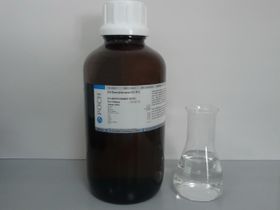Difference between revisions of "Dimethylformamide"
| (5 intermediate revisions by 2 users not shown) | |||
| Line 109: | Line 109: | ||
}} | }} | ||
}} | }} | ||
| − | |||
'''Dimethylformamide''' or '''N,N-dimethylformamide''' is an organic compound with the formula '''(CH<sub>3</sub>)<sub>2</sub>NC(O)H'''. | '''Dimethylformamide''' or '''N,N-dimethylformamide''' is an organic compound with the formula '''(CH<sub>3</sub>)<sub>2</sub>NC(O)H'''. | ||
==Properties== | ==Properties== | ||
===Chemical=== | ===Chemical=== | ||
| − | DMF | + | Reaction of dimethylformamide with a strong base like [[sodium hydroxide]] or strong acid like [[hydrochloric acid]], yields [[dimethylamine]] and [[dimethylamine hydrochloride]] respectively:<ref>Thy Labs, ''Making Dimethylamine: A Chemical Used In Big Pharma,'' [https://www.youtube.com/watch?v=D1pvqXeh3TE https://www.youtube.com/watch?v=D1pvqXeh3TE]</ref> |
| + | |||
| + | : (CH<sub>3</sub>)<sub>2</sub>NC(O)H + NaOH → (CH<sub>3</sub>)<sub>2</sub>NH + HCOONa | ||
| + | : (CH<sub>3</sub>)<sub>2</sub>NC(O)H + HCl → (CH<sub>3</sub>)<sub>2</sub>NH·HCl + HCOOH | ||
| + | |||
| + | DMF has a tendency to penetrate many types of plastic and causes them to swell. | ||
===Physical=== | ===Physical=== | ||
| − | Dimethylformamide is an odorless, colorless liquid, miscible with water and most organic liquids. Technical grade or degraded samples often have a fishy smell due to impurities, such as dimethylamine. | + | Dimethylformamide is an odorless, colorless liquid, miscible with water and most organic liquids. Technical grade or degraded samples often have a fishy smell due to impurities, such as dimethylamine, though obtaining completely 100% odorless DMF is extremely difficult due to dimethylamine's strong odor and is not always done. |
==Availability== | ==Availability== | ||
| Line 123: | Line 127: | ||
==Preparation== | ==Preparation== | ||
| − | Dimethylformamide can be synthesized from [[methyl formate]] and dimethylamine or by reaction of dimethylamine with [[carbon monoxide]]. | + | Dimethylformamide can be synthesized from [[methyl formate]] and [[dimethylamine]] or by reaction of dimethylamine with [[carbon monoxide]].<ref>Weissermel, K.; Arpe, H.-J. (2003). Industrial Organic Chemistry: Important Raw Materials and Intermediates. Wiley-VCH. pp. 45–46</ref> Another route involves carbon dioxide, hydrogen and dimethylamine, in the presence of CuO/ZnO catalyst.<ref>https://www.researchgate.net/publication/45114772_Synthesis_of_dimethylformamide_from_CO2_H2_and_dimethylamine_over_CuZnO</ref> |
==Projects== | ==Projects== | ||
*Acyl halide synthesis | *Acyl halide synthesis | ||
*Make cadaverine | *Make cadaverine | ||
| + | *Make [[dimethylamine]] and dimethylamine hydrochloride | ||
| + | *Vilsmeier–Haack reaction | ||
| + | *Storage of [[acetylene]] | ||
==Handling== | ==Handling== | ||
Latest revision as of 13:57, 26 August 2023
 Dimethylformamide sample and bottle
| |
| Names | |
|---|---|
| IUPAC name
N,N-Dimethylformamide
| |
| Other names
N,N-Dimethylmethanamide
DMF | |
| Identifiers | |
| Jmol-3D images | Image |
| |
| Properties | |
| C3H7NO | |
| Molar mass | 73.10 g/mol |
| Appearance | Colorless liquid |
| Odor | None (fresh) Fishy, amoniacal (old) |
| Density | 0.948 g/mL |
| Melting point | −60.5 °C (−76.9 °F; 212.7 K) |
| Boiling point | 152 to 154 °C (306 to 309 °F; 425 to 427 K) |
| Miscible | |
| Solubility | Miscible with ethanol, toluene |
| Vapor pressure | 516 Pa |
| Thermochemistry | |
| Std enthalpy of
formation (ΔfH |
−240.6–−238.2 kJ mol−1 |
| Hazards | |
| Safety data sheet | LabChem |
| Flash point | 58 °C |
| Lethal dose or concentration (LD, LC): | |
| LD50 (Median dose)
|
1.5 g kg−1 (dermal, rabbit) 2.8 g kg−1 (oral, rat) 3.7 g/kg (mouse, oral) 3.5 g/kg (rat, oral) |
| LC50 (Median concentration)
|
3092 ppm (mouse, 2 hr) |
| Related compounds | |
| Related compounds
|
Formamide |
| Except where otherwise noted, data are given for materials in their standard state (at 25 °C [77 °F], 100 kPa). | |
| Infobox references | |
Dimethylformamide or N,N-dimethylformamide is an organic compound with the formula (CH3)2NC(O)H.
Contents
Properties
Chemical
Reaction of dimethylformamide with a strong base like sodium hydroxide or strong acid like hydrochloric acid, yields dimethylamine and dimethylamine hydrochloride respectively:[1]
- (CH3)2NC(O)H + NaOH → (CH3)2NH + HCOONa
- (CH3)2NC(O)H + HCl → (CH3)2NH·HCl + HCOOH
DMF has a tendency to penetrate many types of plastic and causes them to swell.
Physical
Dimethylformamide is an odorless, colorless liquid, miscible with water and most organic liquids. Technical grade or degraded samples often have a fishy smell due to impurities, such as dimethylamine, though obtaining completely 100% odorless DMF is extremely difficult due to dimethylamine's strong odor and is not always done.
Availability
DMF is sold by various chemical suppliers.
Preparation
Dimethylformamide can be synthesized from methyl formate and dimethylamine or by reaction of dimethylamine with carbon monoxide.[2] Another route involves carbon dioxide, hydrogen and dimethylamine, in the presence of CuO/ZnO catalyst.[3]
Projects
- Acyl halide synthesis
- Make cadaverine
- Make dimethylamine and dimethylamine hydrochloride
- Vilsmeier–Haack reaction
- Storage of acetylene
Handling
Safety
DMF has been linked to cancer in humans, and it is thought to cause birth defects.
Storage
DMF should be kept in closed bottles, away from any acidic vapors. DMF will slowly break down to release dimethylamine.
Disposal
DMF should be mixed with a more flammable solvent and safely burned.
References
- ↑ Thy Labs, Making Dimethylamine: A Chemical Used In Big Pharma, https://www.youtube.com/watch?v=D1pvqXeh3TE
- ↑ Weissermel, K.; Arpe, H.-J. (2003). Industrial Organic Chemistry: Important Raw Materials and Intermediates. Wiley-VCH. pp. 45–46
- ↑ https://www.researchgate.net/publication/45114772_Synthesis_of_dimethylformamide_from_CO2_H2_and_dimethylamine_over_CuZnO
Relevant Sciencemadness threads
- Chemical pages without CAS Registry Number
- Articles without EBI source
- Chemical pages without ChemSpiderID
- Chemical pages without DrugBank identifier
- Articles without KEGG source
- Articles without InChI source
- Articles without UNII source
- Articles containing unverified chemical infoboxes
- Chemical compounds
- Organic compounds
- Solvents
- Polar solvents
- Aprotic solvents
- Amide solvents
- Carcinogenic
- Liquids